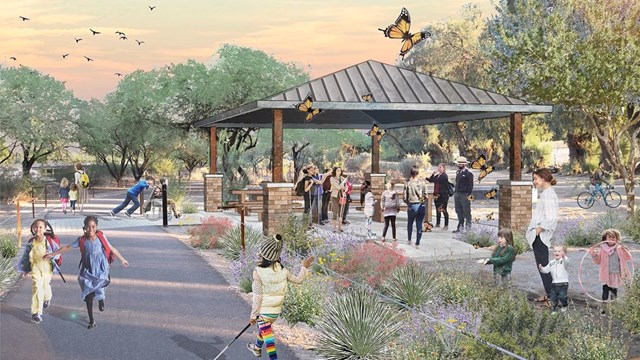Last updated: October 27, 2023
Article
Anza Trail Cultural History Park: A Case Study for Accessible History
Along the Santa Cruz River in Tucson, Arizona, a colorful mural and archway sculpture – by local artists Alonso Delgadillo and Quinton Antone – adorn the entrance to a new urban park. A braille plaque welcomes you to the Anza Trail Cultural History Park in the language of the Tohono O'odham, Spanish, and English:
“Ab g o 'i-wa:pk ¡Bienvenidos! Welcome!”
Linked to the QR code on the plaque is a video with American Sign Language and Audio Description:
Transcript
Throughout this park, find QR codes inside a tactile square like the one in the upper right hand corner. Scan them to learn about the art along this historic trail. Audio description and ASL video included.
- Duration:
- 56.657 seconds
ASL and AD content to accompany the Welcome Plaque at the Anza Trail Cultural History Park in Tucson, AZ
The Anza Trail Cultural History Park (ATCHP) is unique in its design by attempting to answer the challenging questions of accessibility that extend beyond mobility (think infrastructure like ramps and paved or graded pathways) and into learning and cognition. The universally designed park provides a physically accessible space with accessible art and cultural history exhibits.
Parks are, of course, public spaces that are thought of broadly as open and available to all. However, often a park’s accessibility intentions and its actual accessibility widely differ. For instance, how does one interact with visual art – like a mural – with low vision?
- Duration:
- 6 minutes, 6 seconds
Audio described video for the mural, Intersection / Intersección, by Alonso Delgadillo at the Anza Trail Cultural History Park in Tucson, AZ
The project team for the ATCHP attempts to answer this and other accessibility questions through community collaboration, design principles, and adaptive technology.
Relationship building and community collaboration were crucial to the success of the park project. Rather than theorize how someone with low vision or deafness would interact with public art and spaces, the project team invited staff and students at the adjacent Arizona State School for the Deaf and Blind (ASDB) to help design the park. The students advised and tested the mobility of the space and guided the creation of the interactive exhibits and the connected accessible content available through QR codes. The park served as an outdoor classroom for ASDB students through its collaborative creation and continues to do so through its physical and educational space which they helped design.

NPS / Desert Spotlight, Inc.
The linear park, managed by Pima County, follows the Anza Trail and the Santa Cruz River through the very heart of Tucson. The entrance way opens to a plaza lined with native plants and an accessible pathway guides park visitors to interactive exhibits and art installations designed to be experienced through a variety of senses: a tactile expedition map traces the route of the Anza expedition of 1775-76, the Chime art installation can be rung with white canes used by the Blind community and those with low-vision, ASL and audio described content – accessed via QR code – connects users to the stories of those who have traversed this ancient corridor before them, and story boxes showcase the stories and poetry of youth in the community.
The multi-partner, universally designed project was initiated by members of Anza Society Inc., a non-profit community of citizen historians who applied for assistance from the NPS Rivers, Trails, and Conservation Assistance (RTCA) program. RTCA landscape architect and project manager, Laura Bolyard, and Mobility Specialist with ASDB, Anne Rempe, led the ambitious project with support from Pima County and NPS staff from the Juan Bautista de Anza National Historic Trail.

NPS / Desert Spotlight
All involved in the project have commented on how much was learned through the process of designing and implementing the ATCHP park project. There is strength in partnership, and the National Park Service can continue to learn from the communities in which we work, and from the communities we serve. With strong partnerships and the sharing of best practices, universal design elements can be incorporated throughout the National Park System to create more meaningful and equitable spaces.
The park opened officially on January 28, 2023. A ceremony and community celebration accompanied the unveiling of interactive exhibits and public art. The Juan Bautista de Anza National Historic Trail is grateful to those who gave their time and talents to this incredible project, including our colleague Laura Bolyard at the Rivers, Trails, and Conservation Assistance Program, Anne Rempe and the students at the Arizona School for the Deaf and Blind, Ron Quinn and the members of the Anza Society, the board members of the Anza Trail Foundation, and Pima County Parks and Recreation and the Arts Commission, and the community members of Barrio Hollywood in Tucson, Arizona.
Major partner donors include the National Park Foundation, Anza Trail Foundation, Union Pacific Foundation, Anza Society International, Pima County departments, Parklands Foundation, M. Anderson Construction Corporation, and the Southwestern Mission Research Center.

NPS Article from the Rivers, Trails, and Conservation Assistance Program about designing the Anza Trial Cultural History Park

Grand opening of the Anza Trail Cultural History Park on January 28, 2023
